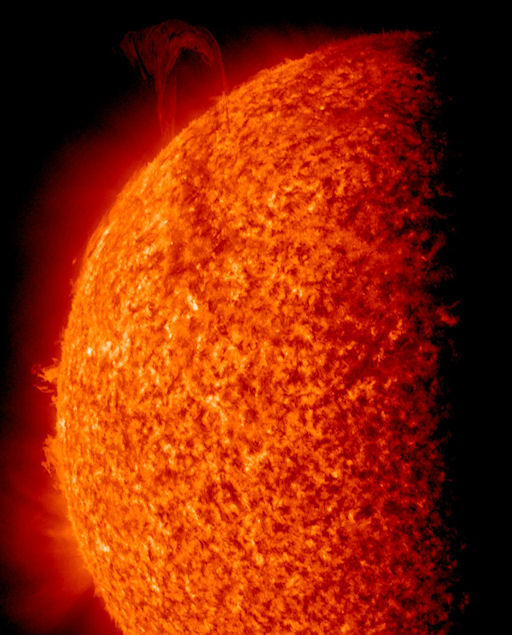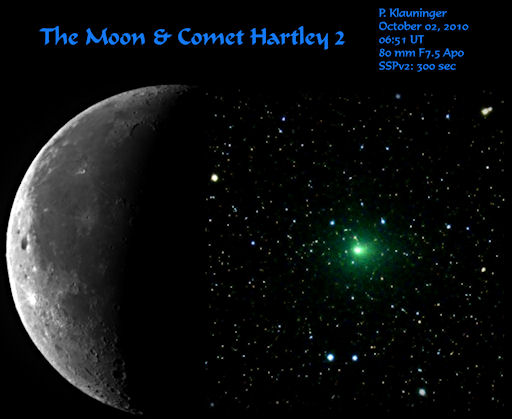AURORA ALERTS: Did you miss the Northern Lights? Next time get a wake-up call from Space Weather PHONE | | |
ONE YEAR UNTIL THE METEOR OUTBURST: Every year around Oct. 8th, Earth passes through a minefield of dusty debris from Comet Giacobini-Zinner, source of the annual Draconid meteor shower. This year, forecasters expect Earth to narrowly miss several of the debris streams, resulting in no appreciable display for 2010. Next year, however, could be different. On Oct. 8, 2011, Earth will have a near head-on collision with a tendril of dust, setting off a strong outburst of as many as 750 meteors per hour. People in Europe, Africa and the Middle East will have a front-row seat for what could be the strongest shower since the Leonid storms a decade ago. Mark your calendar and, meanwhile, follow these links for more information: Draconid forecasts; sky map; history;
FILAMENT ECLIPSE: At this time of year, near the autumnal equinox, the Earth can pass directly between the sun and NASA's Solar Dynamics Observatory, producing a brief eclipse. Yesterday this happened just as a magnetic filament was flying off the sun's northeastern limb. The advancing edge of the Earth cut the sun in half at the moment of maximum eruption:

Click here to view the full-sized image
Even by the lofty standards of SDO, this is a shot of rare beauty. A 5 1/2 hour movie sets the scene in motion; you can see the big-picture (5 MB gif) or a close-up (2 MB mpeg) of the filament. Another movie omits the Earth-shadows; it is easier to follow the filament, yet somehow less photogenic.
The eruption hurled a coronal mass ejection into space (SOHO saw it) but not toward Earth. No geomagnetic storms are expected as a result of the blast.
COMET HARTLEY UPDATE: As comet 103P/Hartley 2 approaches Earth for an 11-million-mile close encounter on Oct. 20th, it grows bigger and bigger in backyard telescopes. The comet's beautiful green atmosphere now subtends an angle approcimately equal to a lunar sea:

Paul Klauninger of Marathon, Ontario, took the picture on Oct. 2nd using a 3-inch refracting telescope. "I photographed the Moon with the same set-up and placed it beside the comet for scale," he says. "In a five minute exposure the comet appears bright green and 7-8 arcminutes across."
Most observers agree that the comet is not yet visible to the naked eye, but may be found using binoculars. Tonight the comet is located a mere 1o from the photogenic Double Cluster in Perseus. Details and a sky map are available from from Sky & Telescope.
more images: from Nick Howes of Cherhill, Wiltshire, UK; from Paul Evans of Larne, Northern Ireland; from P-M Hedén of Vallenuna, Sweden
Sept. 2010 Northern Lights Gallery
[previous Septembers: 2009, 2008, 2007, 2006, 2005, 2004, 2002, 2001, 2000]
Potentially Hazardous Asteroids (
PHAs) are space rocks larger than approximately 100m that can come closer to Earth than 0.05 AU. None of the known PHAs is on a collision course with our planet, although astronomers are finding
new ones all the time.
On October 7, 2010 there were 1149 potentially hazardous asteroids.
Recent & Upcoming Earth-asteroid encounters: | Asteroid | Date(UT) | Miss Distance | Mag. | Size |
| 1999 VO6 | Oct 14 | 34.3 LD | 16.9 | 1.8 km |
| 2010 TK | Oct 16 | 4.5 LD | 25.3 | 39 m |
| 1998 TU3 | Oct 17 | 69.1 LD | 14.6 | 5.2 km |
| 1998 MQ | Oct 23 | 77.7 LD | 16.7 | 1.9 km |
| 2007 RU17 | Oct 29 | 39.2 LD | 18 | 1.1 km |
| 2003 UV11 | Oct 30 | 5 LD | 19.3 | 595 m |
| 3838 Epona | Nov 7 | 76.8 LD | 15.5 | 3.4 km |
| 2005 QY151 | Nov 16 | 77.7 LD | 17.6 | 1.3 km |
| 2008 KT | Nov 23 | 5.6 LD | 28.2 | 10 m |
| 2002 EZ16 | Nov 30 | 73.9 LD | 18.2 | 1.0 km |
| 2000 JH5 | Dec 7 | 47 LD | 17.3 | 1.5 km |
| 2010 JL33 | Dec 9 | 16.6 LD | 17.6 | 1.3 km |
Notes: LD means "Lunar Distance." 1 LD = 384,401 km, the distance between Earth and the Moon. 1 LD also equals 0.00256 AU. MAG is the visual magnitude of the asteroid on the date of closest approach. | | The official U.S. government space weather bureau |
| | The first place to look for information about sundogs, pillars, rainbows and related phenomena. |
| | Researchers call it a "Hubble for the sun." SDO is the most advanced solar observatory ever. |
| | 3D views of the sun from NASA's Solar and Terrestrial Relations Observatory |
| | Realtime and archival images of the Sun from SOHO. |
| | from the NOAA Space Environment Center |
| | from the National Solar Data Analysis Center |

